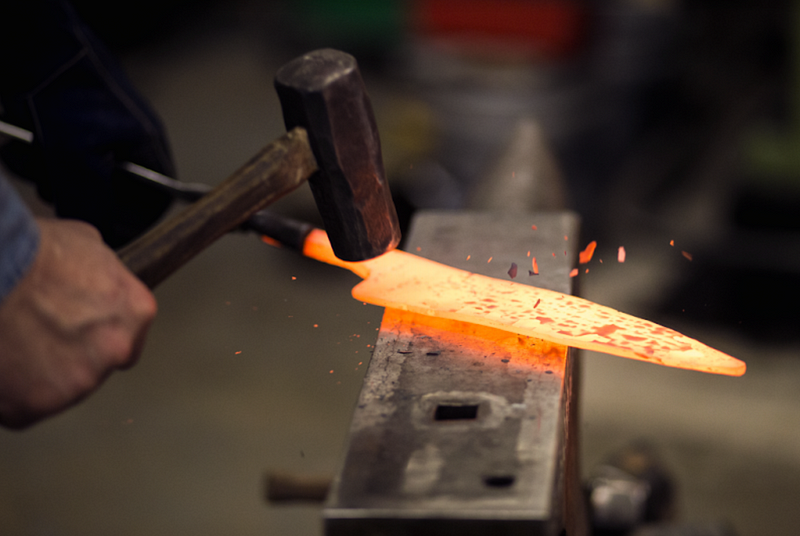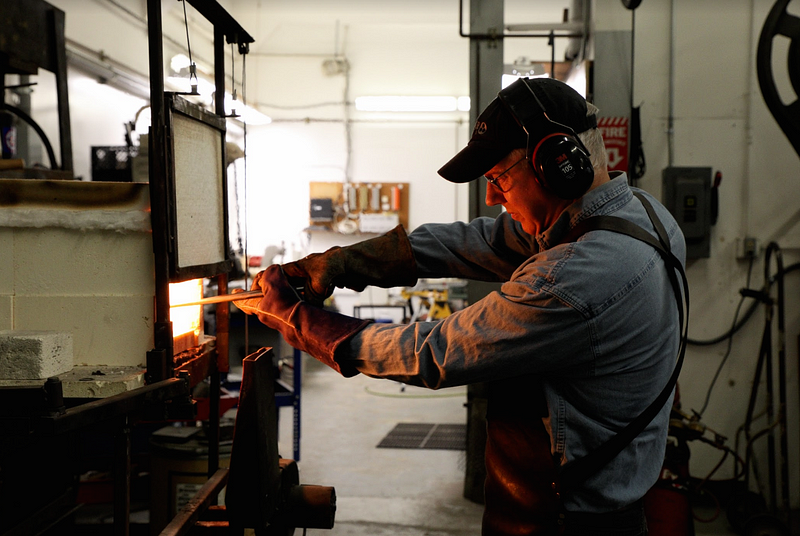Forging Perfection
Constructing the world’s best kitchen knives
Story by JOSH DEJONG | Photos by HARRISON AMELANG

To top-tier chefs, a knife is an extension of the soul. It crafts and aids in creating the most beautiful plates of food imaginable. What if there were a knife so exquisite it put the finest five-star dish to shame?
This is the quality of knife Bob Kramer forges.
Kramer’s knives are held in such high regard, chef, author and TV personality Anthony Bourdain said they are the finest chef’s knives in the world.
“It would be inappropriate to say these are the Rolls Royce of chef’s knives or the Ferrari of chef’s knives because really the car has not been invented that reflects the kind of quality, time, attention and difficulty of the Bob Kramer knife,” Bourdain said in an interview with The Daily Meal.
The knives Kramer makes are so spectacular you must outbid others in an auction or enter into a lottery system for a chance to buy a blade. Many of Kramer’s blades sell for $400 an inch, with an average chef’s knife being 8 inches. With the addition of a hand-carved handle and custom engraving, you are easily looking at a knife worth thousands of dollars.
Kramer, a modest, literally blue-collared, round-spectacled man forges his knives from scratch and reaches a level of detail many other smiths don’t.
Every knife begins by mixing a specific blend of iron, chromium, manganese and carbon powders. An induction coil then heats the metal powder to almost 3,000 degrees Fahrenheit until ready to be cooled into a cupcake-sized ingot.
The ingot will be heated until it resembles the sun in a 2,450-degree Fahrenheit forge. Then it is hammered and stretched into a bar. Kramer cuts the steel and layers it with another bar making a ‘steel sandwich.’ Heat, hammer, stretch, cut and repeat. This process is done until there are about 400 layers of steel.

Kramer then heat treats his blades, a two-and-a-half-day process. The blade is ground down, acid-treated and fit with a handmade handle. The result is a Damascus-style blade with a distinct marble pattern. Japanese Kobe beef would be jealous.
Kramer’s small shop resides in Bellingham’s Sunnyland neighborhood, within view of Homeskillet. There, Kramer and fellow Master Smith Tom Ferry, are continually striving toward perfection with every knife they make.
“Like the horizon, you’re never going to get there,” Kramer said. “It’s something you keep driving towards; there is always room for improvement, there is always room for stuff to learn.”
To become a Master Smith with the American Bladesmith Society, Kramer and Ferry put their blades through rigorous testing. Each bladesmith makes five knives and any imperfection disqualifies them. Only one knife is chosen to be tested.

The blade must cut a one-inch-thick rope, chop into a two-by-four and still be able to shave the hair off an arm. The knife is then put into a vise, which clamps down on where the blade is bent to a 90-degree angle. The blade can’t break. If the blade survives, the creator can be counted among the select few renowned as Master Smiths. Currently, there are just over 115 who have made it through the testing.
Kramer got his start in the knife world while he attended North Seattle Community College in the early ’90s as part of the science program. He was a cook at the Four Seasons in Seattle. The rooms, service, quality, presentation and food construction were all performed with rigorous perfection, Kramer said.
Kramer would go on to learn the basics of knife sharpening in the back of Toshiro’s Hardware in Seattle, because none of his peers knew how to make their knives razor sharp.
Traditional sharpening methods using a whetstone were too time consuming to pursue as a business endeavor for Kramer. He looked for a more reliable mechanical method using power tools.
Knife sharpening was a trade commonly passed down a family line, which led Kramer on a search. The Seattle cutlery store he visited wouldn’t teach him how to sharpen knives, so he traveled across the U.S. Each time Kramer arrived in a new city such as Boston, New York and Chicago, he would crack open the Yellow Pages and find every sharpening shop and cutlery store he could find.

“It wasn’t really great craftsmanship until I got to San Francisco. In San Francisco I went to three cutlery stores which were outstanding old-world craftsmanship,” Kramer said.
On North Beach, he went to a tiny shop named Columbus Cutlery. There, Peter Malattia showed Kramer how to sharpen using a variety of sharpening wheels. Kramer noted the way Malattia sharpened was the same method he had found in a 200-year-old cutlery book.
“I was back with Peter maybe 10 or 15 minutes but it was sort of burned into my head that I need to repeat everything that I saw, I need to figure this out,” Kramer said.
Kramer bought an old 20-foot-long Langendorf bread truck where he would drive to restaurants to sharpen their knives.
“I immersed myself in knife sharpening for about five years, and then eventually thought ‘I wonder how you make a knife? How does that work?,’” Kramer said.
Kramer saw an ad in a specialty knife magazine for a class in Arkansas, where he would first learn how to make a knife. After participating in the workshop, he took the knowledge he had gained and opened a small shop in Seattle where he made and sold knives.
A 1998 article in March with lifestyle magazine Saveur ignited a huge demand for Kramer’s knives creating a four-year backlog. Demand for his knives has hardly died down since.

Kramer doesn’t recall it himself, but while in his Seattle shop, this is when he first met Tom Ferry, the Master Smith he works with today.
“Bob was the first knife maker I actually met,” Ferry said.
Ferry grew up in the Seattle area. He has been involved in both the art and construction world most of his life.
“I did a lot of painting and drawing. My grandmother would actually hire artists to give me weekend classes,” Ferry said.
Ferry worked for Manson Construction in the ’90s building ferry terminals and completing waterfront construction. He quit in 2000 because he was working away from home eight months to 10 months out of the year.
Ferry and his wife looked at their finances, paid down their bills and he dove into knife making.
“I would work in the evenings, work on the weekends, but basically until [my daughter] went into kindergarten I was a stay-at-home dad,” Ferry said.
Ferry’s focus was primarily around making art knives, which led him down a path to learning engraving. Ferry hovers over steel with a pneumatic engraver rapidly pressing a pin into steel.
If he had been taught engraving at 18, Ferry said he would have become an engraver without a doubt.
“That has become my love and my passion,” Ferry said. “whether it’s because it’s such a small scale or it is such detailed work, it doesn’t matter. It’s my thing.”
Kramer hired Ferry to come work under his brand when he moved his shop from Olympia to Bellingham last summer. The pair got together and talked extensively about where each of them were coming from and where they wanted to go moving forward, Kramer said.
“It seemed like a good fit, so we gave it a go and the projects were really successful on every level,” Kramer said. “It was easy to communicate. The work was right on the money. It was exactly what we talked about.”
Ferry pointed out it was uncommon for two Master Smiths to work out of the same shop. He said one Master Smith may hand off a blade to another for them to do the handle, but they don’t work continuously with one another.
“Nobody’s been as tight as we’ve got right now,” Ferry said. “I think it is going to be interesting to see what comes out of this shop, I am excited to see what comes out of this shop. I think the possibilities are endless.”